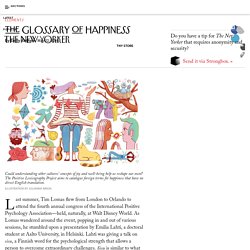

The Glossary of Happiness. Last summer, Tim Lomas flew from London to Orlando to attend the fourth annual congress of the International Positive Psychology Association—held, naturally, at Walt Disney World.

As Lomas wandered around the event, popping in and out of various sessions, he stumbled upon a presentation by Emilia Lahti, a doctoral student at Aalto University, in Helsinki. Lahti was giving a talk on sisu, a Finnish word for the psychological strength that allows a person to overcome extraordinary challenges. Sisu is similar to what an American might call perseverance, or the trendier concept of grit, but it has no real equivalent in English. It connotes both determination and bravery, a willingness to act even when the reward seems out of reach. Lomas had never heard the word before, and he listened with fascination as Lahti discussed it. The idea, Lomas acknowledged, is speculative. Dimensions - Geert Hofstede. About the research Professor Geert Hofstede conducted one of the most comprehensive studies of how values in the workplace are influenced by culture.

He analysed a large database of employee value scores collected within IBM between 1967 and 1973. The data covered more than 70 countries, from which Hofstede first used the 40 countries with the largest groups of respondents and afterwards extended the analysis to 50 countries and 3 regions. Subsequent studies validating the earlier results include such respondent groups as commercial airline pilots and students in 23 countries, civil service managers in 14 counties, 'up-market' consumers in 15 countries and 'elites' in 19 countries. In the 2010 edition of the book Cultures and Organizations: Software of the Mind, scores on the dimensions are listed for 76 countries, partly based on replications and extensions of the IBM study on different international populations and by different scholars. Culture only exists by comparison More information. 10 minutes with...Geert Hofstede on Masculinity versus Femininity 10112014.
10 minutes with Geert Hofstede on Long versus Short Term Orientation 01032015. 10 minutes with Geert Hofstede on Uncertainty Avoidance 01032015. 10 minutes with Geert Hofstede on Individualisme versus Collectivisme 10112014. 10 minutes with Geert Hofstede... on Power Distance 10112014. Geert Hofstede on Culture. Seven deadly sins speech 2011. How Culture Drives Behaviours. Learn a new culture. Countries - Geert Hofstede. Please select a country in the dropdown menu below to see the values for the 6 dimensions.

After a first country has been selected, a second and even a third country can be chosen to be able to see a comparison of their scores. To compare your personal preferences to the scores of a country of your choice, please purchase our cultural survey tool, the Culture Compass™. Correctly interpreting country scores Please note that culture is defined as the collective mental programming of the human mind which distinguishes one group of people from another. This programming influences patterns of thinking which are reflected in the meaning people attach to various aspects of life and which become crystallised in the institutions of a society.
This does not imply that everyone in a given society is programmed in the same way; there are considerable differences between individuals. Liaison Interpreting. Interpretación bilateral (ISSPP) Working with interpreters in the community. Mediadors magribins (español) Understanding the interpreter's role. When family members interpret. Tensions between personal and professional boundaries. Encountering awkward characters. Informal disclosures. IMIA - International Medical Interpreters Association. NCIHC National Code of Ethics. Blindsided – Liz Essary, Certified Spanish Interpreter. That Interpreter teaches a basic training for medical interpreters.

Basic. Every single time I teach the class, the number one piece of feedback, by leaps and bounds, is that it would be nice to spend more time learning terminology in Spanish. Every. Single. Time. And please don’t misunderstand the “basic” in “basic training” to mean “easy”. I totally understand why students want more focus on terminology.
Interpreting practice in real life is really awkward when you don’t have a good terminology base. On the first day of class, I already know that on the last day of class, the evaluations are going to say things like, “I wish we’d spent more time on terminology” and so I address it right up front. And that’s when they have to rely on their interpreting skills. Even now, I get blindsided. And that’s just the stuff that patients say! Interpreting for a doctor who’s explaining a procedure to his patient that, given his condition, is probably not going to survive it. Like this: